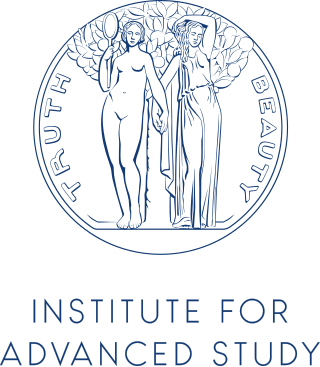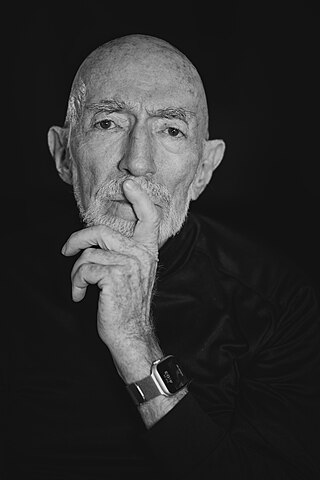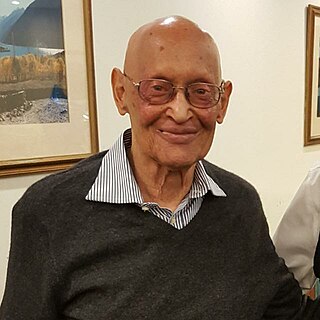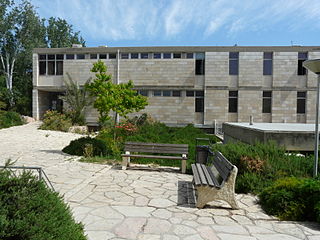
Paul Adrien Maurice Dirac was an English mathematical and theoretical physicist who is considered to be one of the founders of quantum mechanics. Dirac laid the foundations for both quantum electrodynamics and quantum field theory. He was the Lucasian Professor of Mathematics at the University of Cambridge, a professor of physics at Florida State University and a 1933 Nobel Prize in Physics recipient.

Max Born was a German-British theoretical physicist who was instrumental in the development of quantum mechanics. He also made contributions to solid-state physics and optics and supervised the work of a number of notable physicists in the 1920s and 1930s. Born was awarded the 1954 Nobel Prize in Physics for his "fundamental research in quantum mechanics, especially in the statistical interpretation of the wave function".

The University of Göttingen, officially the Georg August University of Göttingen, is a public research university in the city of Göttingen, Lower Saxony, Germany. Founded in 1734 by George II, King of Great Britain and Elector of Hanover, it began instruction in 1737 and is recognized as the oldest university in Lower Saxony.

The Institute for Advanced Study (IAS) is an independent center for theoretical research and intellectual inquiry located in Princeton, New Jersey. It has served as the academic home of internationally preeminent scholars, including Albert Einstein, J. Robert Oppenheimer, Hermann Weyl, John von Neumann, Michael Walzer, Clifford Geertz and Kurt Gödel, many of whom had emigrated from Europe to the United States.

Rudolf Ludwig Mössbauer was a German physicist best known for his 1957 discovery of 'recoilless nuclear resonance fluorescence', for which he was awarded the 1961 Nobel Prize in Physics. This effect, called the Mössbauer effect, is the basis for Mössbauer spectroscopy.

Kip Stephen Thorne is an American theoretical physicist and writer known for his contributions in gravitational physics and astrophysics. Along with Rainer Weiss and Barry C. Barish, he was awarded the 2017 Nobel Prize in Physics for his contributions to the LIGO detector and the observation of gravitational waves.

Joseph Hooton Taylor Jr. is an American astrophysicist and Nobel Prize laureate in Physics for his discovery with Russell Alan Hulse of a "new type of pulsar, a discovery that has opened up new possibilities for the study of gravitation."

Russell Alan Hulse is an American physicist and winner of the Nobel Prize in Physics, shared with his thesis advisor Joseph Hooton Taylor Jr., "for the discovery of a new type of pulsar, a discovery that has opened up new possibilities for the study of gravitation".

Jerome Isaac Friedman is an American physicist. He is institute professor and professor of physics, emeritus, at the Massachusetts Institute of Technology. He won the 1990 Nobel Prize in Physics along with Henry Kendall and Richard Taylor, "for their pioneering investigations concerning deep inelastic scattering of electrons on protons and bound neutrons, which have been of essential importance for the development of the quark model in particle physics.", work which showed an internal structure for protons later known to be quarks. Friedman sits on the board of sponsors of the Bulletin of the Atomic Scientists.
Carroll Overton Alley, Jr. was an American physicist. He served as the Principal Investigator on the Apollo Program's Lunar Laser Ranging Experiment, which significantly restricted the possible range of spatial variation of the strength of the gravitational interaction. Alley was a PhD student of Robert Henry Dicke.

Daniel Chee Tsui is an American physicist. He is currently serving as the Professor of Electrical Engineering, emeritus, at Princeton University. Tsui's areas of research include electrical properties of thin films and microstructures of semiconductors and solid-state physics.

Robert M. Wald is an American theoretical physicist and professor at the University of Chicago. He studies general relativity, black holes, and quantum gravity and has written textbooks on these subjects.

The MIT Department of Physics has over 120 faculty members, is often cited as the largest physics department in the United States, and hosts top-ranked programs. It offers the SB, SM, PhD, and ScD degrees. Fourteen alumni of the department and nine current or former faculty members have won the Nobel Prize in Physics.The Department of Physics was born when MIT founder William Barton Rogers proposed in 1865 to bring their Mens et Manus philosophy to life by creating a new laboratory of physics and mechanics in another department’s back room.

Charles William Misner was an American physicist and one of the authors of Gravitation. His specialties included general relativity and cosmology. His work has also provided early foundations for studies of quantum gravity and numerical relativity.

Asghar QadirHI, SI, FPAS, is a Pakistani mathematician and a prominent cosmologist, specialised in mathematical physics and physical cosmology. Nowadays, he is widely considered one of the top mathematicians in Pakistan. Asghar has played a prominent role in promoting Relativity in Pakistan. To this day, Qadir has made important and significant contributions to the fields of differential equations, theoretical cosmology and mathematical physics. He is noted for his work in mathematics and mathematical physics, in particular his contributions to general relativity and cosmology.
The Physics Department at the University of California, Santa Barbara has 58 faculty members. It offers academic programs leading to the B.A., B.S., and Ph.D. degrees.

The Racah Institute of Physics is an institute at the Hebrew University of Jerusalem, part of the faculty of Mathematics and Natural Sciences on the Edmund J. Safra Campus in the Givat Ram neighborhood of Jerusalem.

The Princeton University Department of Economics is an academic department of Princeton University, an Ivy League institution located in Princeton, New Jersey. The department is renowned as one of the premier programs worldwide for the study of economics. The university offers undergraduate A.B. degrees, as well as graduate degrees at the Ph.D. level. It is often considered one of the "big five" schools in the field, along with the faculties at the University of Chicago, Harvard University, Stanford University, and MIT. According to the 2023-2024 U.S. News & World Report, its graduate department is ranked as the joint No. 4 in the field of economics, in a four-way tie between it, the University of Chicago, Yale University, and the University of California, Berkeley.

The Princeton University Department of Mathematics is an academic department at Princeton University. Founded in 1760, the department has trained some of the world's most renowned and internationally recognized scholars of mathematics. Notable individuals affiliated with the department include John Nash, former faculty member and winner of the 1994 Nobel Memorial Prize in Economic Sciences; Alan Turing, who received his doctorate from the department; and Albert Einstein who frequently gave lectures at Princeton and had an office in the building. Fields Medalists associated with the department include Manjul Bhargava, Charles Fefferman, Gerd Faltings, Michael Freedman, Elon Lindenstrauss, Andrei Okounkov, Terence Tao, William Thurston, Akshay Venkatesh, and Edward Witten. Many other Princeton mathematicians are noteworthy, including Ralph Fox, Donald C. Spencer, John R. Stallings, Norman Steenrod, John Tate, John Tukey, Arthur Wightman, and Andrew Wiles.
The Cyrus Fogg Brackett Chair of Physics is an endowed professorship established at Princeton University in 1927 by a donation from Thomas D. Jones in honor of Cyrus Fogg Brackett (1833–1915), who was a professor of physics at Princeton University and founder of Princeton University's electrical engineering department.


















